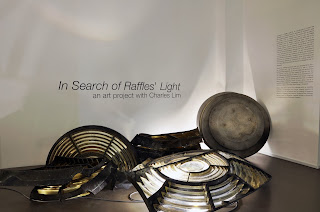Diary of an NUS Museum Intern: Richmond Tan
Note: Diary of an NUS Museum Intern is a series of blog posts written by our interns about their experiences during the course of their internships. Working alongside their mentors, our interns have waded through tons of historical research, assisted in curatorial work, pitched in during exhibition installations and organised outreach events! If you would like to become our next intern, visit our internship page for more information!
-



-
Richmond Tan is a first-year History student at the NUS Faculty of Arts and Social Sciences. Richmond joined the Museum Outreach team, working to conceptualise programmes for the Museum's 2016 slate of events, in particular programmes for the current exhibition Vietnam 1954-1975.
I was involved in assisting with the planning of programmes for the exhibition Vietnam 1954 – 1975: War Drawings and Posters from the Ambassador Dato’ N. Parameswaran Collection, as well as planning for the upcoming Art on Campus Facebook series. In these brief but fulfilling five weeks of assisting with the Outreach programmes, I was able to better familiarise myself with the roles and responsibilities of outreach in the context of a university museum.
I was involved in assisting with the planning of programmes for the exhibition Vietnam 1954 – 1975: War Drawings and Posters from the Ambassador Dato’ N. Parameswaran Collection, as well as planning for the upcoming Art on Campus Facebook series. In these brief but fulfilling five weeks of assisting with the Outreach programmes, I was able to better familiarise myself with the roles and responsibilities of outreach in the context of a university museum.
As
students of history, the Vietnam War offers a case study that highlights the
importance of contesting assumptions implied in terms like “Cold War” that are
often accepted uncritically. In particular, the conflict that shaped and was
shaped by the tensions between the American and Soviet blocs played out
differently outside of the “West” – in Vietnam, Laos, Cambodia, the violence
and turmoil that shaped its post-World War II realities were anything but “cold”.
Hence, doing this research as preparation was a necessary and timely reminder
to consider and be aware of the Western-centric lens we may adopt when studying
the past.
To
supplement the research I was doing, I read William J. Duiker’s book, “Sacred
War: Nationalism and Revolution in A Divided Vietnam”. The book was
comprehensive in covering the North Vietnamese perspective – not only the
period of 1954-1975, but also tracing the roots of revolution, the formation of
North Vietnamese state as well as the subsequent resistance against the French.
With an understanding of the period leading up to 1954, I identified themes I
considered important for this exhibition, such as the notions of loss and
trauma in war. Hence, the films and topics I suggested sought to bring out this
theme of loss through the narratives of individuals experiencing the conflict.
In
addition to doing research and planning programmes, I also sat in an ARI
Cultural Studies Seminar listening to Assoc. Prof Thy Phu’s presentation on
“Revolutionary Vietnamese Women and Global Solidarity”. The talk and subsequent
discussion was engaging and interesting as the representation of women in
revolutionary contexts were discussed, both within the Vietnam War but also
comparatively to other conflicts. This highlighted the theme of representation for
the exhibited collection as well as the programmes, which I hope would be a
recurring motif that those attending the programmes might recognise and discuss.

Minh Hai, Silence the American
Cannons!, 1969, Mixed media hand-painted
poster on paper, 39.5 x 57.3cm
I
also assisted with planning the Art on Campus Facebook series, where the NUS
and NUS Museum Facebook page would release a series of posts on the public art
in NUS. In doing so, there might be a greater appreciation for the works
presently located on campus, from the familiar I Was Here to other works that receive less attention. Interest in
the series might generate greater awareness for the NUS Museum and its Facebook
page, maximising the potential of the Facebook page in generating the feedback
of and suggestions for the various museum activities.
Besides
the tasks for our specific roles, all the interns were also involved in the
reading programme organised by Michelle that was designed to complement our activities.
We learnt more about the origins of the NUS Museum and its development, the
history of art in Singapore as well as the curator and curatorial function. We also visited the Baba House and National Gallery
Singapore, where both trips were made more meaningful and memorable thanks to
the readings that we had to familiarise ourselves with the site and the works
respectively.

Interns (L-R): Sherlyn, Hui Tuan, Tinesh, Richmond, Han Siang, Austin,
Geryl, Ignatius; Jeryl and Han Siang were interns at the NUS Centre For the
Arts
Another
important learning opportunity came through the curatorial tour given by
Kenneth on Sheltered: Documents For Home and The Library of Pulau Saigon. We learned more about the strategies
and considerations in the planning of an exhibition, while asking questions and
clarifying doubts regarding curatorial work, such as working with artists and
organisation of space when considering how the viewers might navigate and view
and exhibition.

Curatorial tour on Sheltered: Documents For Home by Kenneth
This
internship has been a great experience and I enjoyed learning about the museum
and assisting with its programmes. In addition, having written initially that I
wanted to participate in this internship to “understand the general demands and
constraints of museum work”, being able to witness the work behind-the-scenes ensured
that I was able to do that and more.
On
this note, I would like to thank my supervisors, Michelle and Trina, for their
patience and guidance throughout the internship, the other members of the
museum team as well as fellow interns – Austin, Hui Tuan, Ignatius, Sherlyn and
Tinesh for their delightful company and
discussions.


Comments
Post a Comment